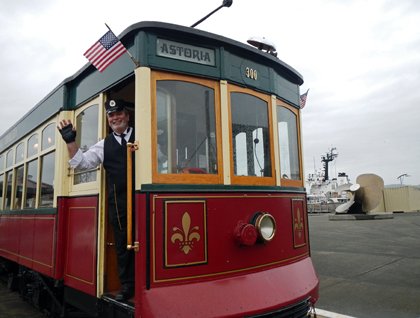Sea Bird visits Astoria, Oregon
Astoria, Oregon Daily Expedition Report
By Grace Winer / Published at Expeditions.com
Sailing into Astoria in the earliest light of dawn we pass near the lights of a giant cargo ship. We make a turn to portside and approach our dock across from a large U.S. Coast Guard ship. Captain Kay expertly maneuvers the National Geographic Sea Bird alongside and our sailors make the lines fast to the dock. First thing this morning we all travel to Fort Clatsop, the site where Lewis and Clark and their Corps of Discovery spent the winter of 1805-06. On the way we see a large herd of Roosevelt Elk, most likely descendants of the very animals that sustained the Corps of Discovery through their stay at Fort Clatsop. Following an orientation we are guided by a ranger as we visit a replica of the fort and learn about living conditions during that difficult winter. Then we take a walk in the woods—a temperate rain forest. We walk down a path beneath towering Sitka spruce and see, in addition to the wonderful plants, a sassy Douglas squirrel, a winter wren, some chestnut-backed chickadees, and a beautiful blue Steller’s jay.
On our way back into Astoria we drive up the winding road to the top of Coxcomb Hill for a look at a local landmark, the famous Astoria Column. Many of us climb the winding 164 steps to the top for a stunning view of the countryside and the river. Next is the excellent Columbia River Maritime Museum—one of the best maritime museums in the country. Here we learn about the treacherous Columbia Bar, known as the “Graveyard of the Pacific.” This is where the Columbia, the Great River of the West meets the swells of the Pacific Ocean head on. The incessant roaring and wildness of these tumultuous waters have long been said to be the most fearsome sight to greet the eye of a sailor. In the museum is a small blue-and-white Japanese fishing boat. This small craft was swept away by the great 2011 tsunami in Japan and washed up two years later on the Washington shore just north of the mouth of the Columbia. The owner was found and he donated the boat to the museum.
Read the rest of the story at Expeditions.com